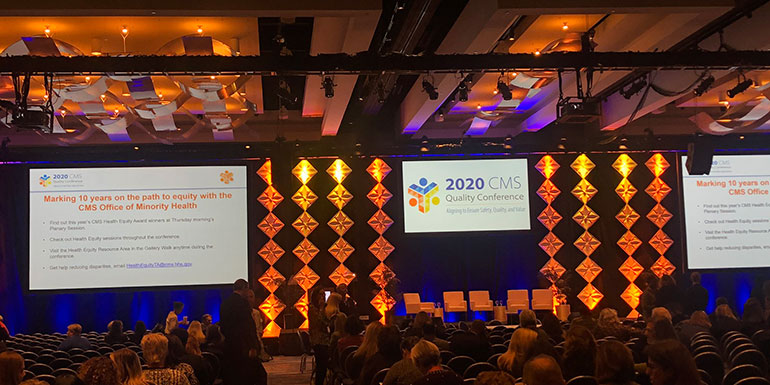Best Practices for Clinical Registries with New Research Priorities

You set goals, outlined plans, and hit milestones. Then 2020 changed - in a big way. Questions came. Priorities shifted. Opportunities emerged.
Despite uncertainty, there are a few things to be sure about:
- Registries are essential to our understanding of the direct and indirect effects of the pandemic.
- Registries must adapt to address emerging research priorities and questions.
- Registries can pivot successfully with the right strategy, technology, and partners.
Successful patient registries are designed to pivot. Flexibility is inherent and technology scales as needs evolve. Consider how the following organizations changed course to address pressing issues and emerging research questions.
- The current healthcare landscape: The American Academy of Physical Medicine and Rehabilitation (AAPM&R) is adapting its registry to answer important research questions and track long-term patient outcomes.
- The COVID-19 pandemic: The Acute Care Quality Registry quickly adapted its technology to monitor and manage the effects of the pandemic on patients, hospitalists, and health systems.
- The national opioid epidemic: The Michigan Surgical Quality Collaborative leveraged its registry to establish evidence-based guidelines, track adherence to those guidelines, and ultimately reduce post-op opioid prescribing by 30% and consumption by 50%.
We shared these examples during a recent webinar, “How to Pivot Your Registry and Meet New Priorities.” You can view it on-demand here and read on to learn the steps you can take to ensure your registry is ready to pivot and meet new priorities whenever they arise.
Step 1: Determine the Priorities and Research Questions Your Registry Can Uniquely Answer
Often with a registry, it's tempting to start with the data you can easily collect and then make sense of it all. But this quickly leads to overwhelming data volume with a lack of specificity.
Instead, flip the script and begin with the end in mind. Use this framework and ask yourself the following:
- What are your goals and objectives? How have they changed? Which ones are inherently important – no matter what changes have happened?
Clinical guidelines, patient engagement, physician engagement, and research are all timeless goals. But they may require specificity and some shifts. Identifying what’s truth and accommodating necessary changes ensures that your registry will still point in your organization’s North Star, with a shared set of priorities. Documenting this will help to assess opportunities and minimize distractions, even when those distractions seem monumental.
- What output will help you reach these priorities and goals? In other words, your goals should define what’s visible in your registry. What do your clinical, scientific, and patient communities need to achieve these aims. The reports, dashboards, workflows, and predictive calculators and tools in your registry should deliver the insights your stakeholders need to take action.
- Your registry’s outputs drive how the data should be combined and adjusted. This includes your measures and cohorts, peer groups, benchmarks, and more. How will you measure what matters? What elements and assets need to be combined in order to support those measures?
- Finally come the data. What individual data elements do you need? How will you collect that data securely, efficiently, and accurately?
This process isn't something to do only once or only during implementation. It is something to document and revisit every time there is a shift in your specialty or practice. Doing this will help ensure that the changes and adjustments to your strategy and registry continually serve both your people and your priorities.
Step 2: Use Trusted Data and Advanced Analytics to Address Critical Issues
Addressing new and emerging health issues requires rapid measurement and quick discoveries.
It involves having the right framework that involves two things:
- A comprehensive data collection strategy that ensures you have all the right data.
- Advanced registry analytics that help you answer all the right questions.
Registry Data Collection Strategy
Different data sources supply different information to ultimately evaluate a health issue. Most registries rely on clinical data from the EHR. But most data sources – EHR data especially – has inherent limitations. Clinical data alone often doesn’t provide all of the information needed to fully understand a health issue.
This means registries that rely on EHR or clinical data alone will have data gaps. Yet solving some of the most intractable issues in healthcare will require innovative methods of blending data to deliver a complete view of a patient population. In fact, multiple studies have shown that nearly 80% of health outcomes are attributed to what happens beyond the walls of a health system.
You can address these gaps with a comprehensive data acquisition strategy that leverages not only at EHR data but also administrative datasets, claims datasets, and governmental datasets. You can also use specialized case report forms, provider and patient surveys, and other methods for collecting patient-sourced data.
Collecting data in which you're able to assess root causes of health issues by having all sorts of associated factors that are at play will also enable you to effectively pursue data-driven interventions to improve outcomes and improve care delivery by our providers.
Advanced Registry Analytics
Once you start collecting data, you need to be able to use it to answer the right questions. Enter advanced analytics.
In healthcare, questions seem endless – especially with any emerging issue or research priority. These questions fall into four common types, and there are specialized analytics to address each.
- What happened? Descriptive analytics answers this question by examining data from the past and producing dashboards around trend or benchmarking data. The uses of descriptive analytics can be very limited, especially for healthcare stakeholders who ultimately want to influence health outcomes and have foresight into what might happen in the future.
- What is likely to happen next? Predictive analytics answers this question using modeling and forecasting techniques. Predictive analytics can have limitations, as it is based on determining what will happen if all conditions remain the same, and healthcare leaders often want to understand what will happen after novel interventions or actions.
- What will the effects be if we take some type of action? Prescriptive analytics answers this question using machine learning and numerous inputs to suggest a course of action. For example, decision support calculators use real-time patient data and prescriptive analytics to determine optimal treatment courses based on expected outcomes and likely complications.
- What do we need to explore further? Discovery analytics answers this question using machine learning to analyze raw data, which allows it to determine interconnections, patterns, and outliers that warrant further exploration.
Step 3: Leverage a Flexible Data Infrastructure to Pivot at Any Time
Your new aims, data strategy, and analytics approach can come to life with flexible registry technology and the right registry partner. Modern clinical data registries are designed to evolve as your needs change. Your clinical data registry technology should provide you the ability to:
- Ingest data and apply analytics in real time.
- Collect new data fields and add new measures.
- Rapidly design, build, and distribute patient and provider surveys.
- Intelligently make data available and accessible via web-based reports and dashboards.
Each of the organizations below leveraged their flexible registry technology and data infrastructure to be proactive in measuring, monitoring, and addressing the COVID-19 pandemic.
- Sound Physicians embedded logic into their analytics technology and steps into their clinical workflows to understand the coronavirus impact on daily admissions, bed capacity, resource utilization, provider well-being, and standard acute care, at a local, regional, and national level. (Read this blog post to learn more about how the largest hospitalist group in the U.S. uses data and analytics to understand COVID-19).
- The Extracorporeal Life Support Organization (ELSO) is using registry data and insights to lead education efforts around the use of extracorporeal life support (ECLS) and extracorporeal membrane oxygenation (ECMO) as a treatment for patients with COVID-19. (This blog post explains more about how a global ECMO organization uses a patient registry to track and educate on COVID-19.)
- The American Society of Clinical Pathology (ASCP) launched COVID-19 specific reports in its National Pathology Quality Registry to better understand positive, negative, inconclusive, and cancellations. They are also tracking test processing times.
- The Palliative Care Quality Collaborative (PCQC) rapidly designed, built, and deployed a survey to collate experiences of palliative care clinicians in caring for COVID-19 positive, PUI (Person Under Investigation), and recovered patients. They plan to share these experiences with the palliative care community to drive understanding and clarity in the field through continuous learning. (Learn more about how PCQC quickly adapted their registry.)
- The National Hemophilia Foundation (NHF) added COVID-19-specific questions to patient surveys that inform their research registry centered exclusively on patient-sourced data.
- Conquering CHD launched InformCHD, a patient-reported database, that will collect information directly from people with congenital heart disease who are potentially at risk for severe complications related to COVID-19. (Read more here about how they are using patient-sourced data to understand COVID-19 and Congenital Heart Disease.)
The Right Registry Technology Makes Discovery Possible
The ultimate purpose of a clinical data registry is to accurately observe, measure, and understand the true realities of healthcare today. Emerging questions and issues, along with the complexities of real-world data, make this more challenging. None of this important work comes easy. But, as Galileo once said, “All truths are easy to understand once they are discovered.”
When it comes to developing and growing clinical registries that address today’s most important questions, the right technology can support this discovery.
What You Can Learn from Registries with Solid Patient-Reported Outcomes Programs

Can you hear it? The patient voice is getting louder.
Healthcare organizations are increasingly using patient reported outcome surveys to gather information about health status, symptoms, and patient-centered outcomes that take place in between visits and outside of a physician’s scope of access.
The data collected not only makes patient records more complete and accurate for the research initiatives of the sponsoring organization, but also encourages:
- Shared decision making.
- Family engagement.
- Longitudinal patient engagement at scale.
Let’s look at examples of how three registries are using patient-reported outcomes (PROs) to advance their research programs.
How MUSIC Uses PROs to Inform Shared Decision Making
The Michigan Urological Surgery Improvement Collaborative (MUSIC) is a physician-led quality improvement organization that evaluates and improves the quality and cost efficiency of care for patients with prostate cancer and other urologic diseases.
The statewide MUSIC registry is a recognized leader in urologic quality improvement. MUSIC’s significant program results make it a national example of the benefits of collaboration and using data, including PROs, for improving patient care.
- Achieving a 50% reduction in prostate biopsy-related hospitalizations by implementing process changes for antibiotic prophylaxis focused on addressing fluoroquinolone resistance.
- Using data to develop and implement evidence-based appropriateness criteria for radiographic staging of all men with newly diagnosed prostate cancer.
- Developing an infrastructure for video-based assessment of surgical technique with the aim of linking such assessments with patient-reported outcomes and perioperative morbidity data.
Quality Improvement Priorities
One of MUSIC’s key priorities focuses on improving patient outcomes after radical prostatectomy. To achieve this goal, MUSIC and ArborMetrix developed the infrastructure for measuring and improving longitudinal functional outcomes and health-related quality of life after radical prostatectomy.
PRO Program Design
MUSIC uses patient-sourced data to understand the longitudinal trends of treatment effects. Here’s a high-level look at their program:
- Patients receive a baseline questionnaire before surgery, and then receive the same survey at three, six, 12, and 24 months following surgery.
- All data flows directly into MUSIC’s registry.
- Patients review their survey responses with their physicians via a PRO Patient Summary Report. Each patient’s individualized report helps the patient and physician better plan for the patient’s recovery pathway following surgery.
Results with PRO
When it comes to the success of any registry program, measurable, published results are the arbiter.
MUSIC frequently publishes peer-reviewed manuscripts using registry data. The two papers below demonstrate the high response rates achieved, and the use of industry standard measures to gauge quality of life after surgical interventions.
A study published in the September 2017 edition of Urology concluded that “Collection of electronic PRO via this unified, web-based format was successful and provided results that reflect expected recovery and identify opportunities for improvement.”
The study published in August 2019 edition of the Journal of Clinical Oncology examined the validity of PROMIS measures following radical prostatectomy and concluded that “PROMIS Global Satisfaction With Sex Life and Interest in Sexual Activity single-item measures are fundamental measures in prostate cancer survivorship. Patients are interested in sex despite functional losses and can salvage satisfaction, thereby giving insight into attainable patient-centered survivorship goals for sexual recovery after radical prostatectomy.”
Key Takeaways for Your PRO Program
- Clinical focus on specific procedures and patient cohorts allows for deeply granular data collection that supports meaningful quality improvement.
- Patient follow-up cadence is clinically relevant to the procedure, capturing data at intervals important for trending.
- The scope of the PRO surveys captures important quality of life and mental and emotional health variables that provide important context to recovery data.
How PC4 Extends Patient Engagement to Family Engagement in PROs
The Pediatric Cardiac Critical Care Consortium (PC4) aims to improve the quality of care for pediatric heart patients through transparent data sharing that allows hospitals to evaluate their own outcomes and learn best practices.
Research Priorities
PC4 uses patient-reported outcomes to collect routine standardized longitudinal data on children who have undergone congenital heart surgery. With improvements in early survival following congenital heart surgery, it has become increasingly important to understand longer-term outcomes. But routine collection of these data is challenging and remains very limited.
PRO Program Design
PC4 data collection goals from patients and families encompass all aspects of physical, mental, emotional and social health, and follow patients through to their adulthood. Because these surveys tend to collect many variables, they have designed their survey frequency and formats to be as low-burden as possible, while still collecting the required data elements.
- PC4 PRO data collection occurs annually and is age-customized.
- The survey includes both a general questionnaire and specific quality-of-life questions related to school performance, physical activity, and other measures.
- The PRO module is directly integrated with the PC4 registry, which allows for automated identification of eligible patients and integration of the follow-up data with baseline demographics and clinical data contained within the registry.
The PRO system is designed to automatically generate an email with a pre-authenticated link for age-appropriate survey completion for those who meet criteria and are due for follow-up. PC4 uses email as its PRO methodology, as preferred by patients and families.
Key Takeaways for Your PRO Program
- Customize your survey to engage your target patient demographic. This is for both the technology that you use to deliver the survey, and the language in which you write the survey.
- Engage your population for the long term to allow for deeper understanding of longitudinal outcomes that could open many new opportunities for meaningful research.
- Don’t forget the families. Caregivers and families play an important role in providing important health information for patient populations with limited mobility or technical sophistication.
How the National Hemophilia Foundation Delivers Longitudinal Patient Engagement at Scale
The National Hemophilia Foundation (NHF) partnered with us to deliver a patient-centric research registry focused on improving the quality of life of persons with a bleeding disorder and enhancing the ability of external researchers to discover and measure the impact of transformational therapies.
Research Priorities
NHF is using PRO data to drive rapid-cycle research. While they utilize PRO in the traditional format of highly detailed, structured, and coordinated surveys delivered on a specific cadence, they also use PRO to do rapid response surveys on hot topics that impact their population.
The hot topic surveys are typically fewer than 10 questions. They have included topics ranging from vaping use in specific patient cohorts to how the COVID pandemic has affected the community. These rapid-response surveys help inform and adjust NHF’s emerging research priorities.
PRO Program Design
Especially important, NHF also helps affected individuals’ level-set their experience compared to others.
Patient-facing reporting uses deidentified and aggregated data from other patients in their cohort filtered by diagnosis or other relevant demographic and clinical attributes. This powerful reporting encourages participants to engage in PRO surveys so they can unlock additional reporting topics and add their data to the community totals.

NHF Longitudinal Patient Dashboard Displays Aggregated Community Statistics
Key Takeaways for Your PRO Program
- PROs can be used with engaged patient populations to rapidly gather data on emerging health topics.
- Providing data back to patients encourages ongoing engagement in survey participation and gives them a powerful tool for shared decision-making.
- Patients who see their data next to other patients like them have context and clarity on their own experiences.
Patient-reported outcomes provide a more insightful data story.
We continue to invest in robust, easy-to-use patient-reported outcome tools that collect the right data from the right patients at the right time. PRO platforms are the optimal mechanism for capturing subjective symptoms and quality of life metrics, without the data passing through the interpretive filters inherent in outcomes recorded in the medical record.
Let’s brainstorm which of your programs, personas, and patient cohorts that could benefit from this powerful toolset.
If you have any questions or would like to learn more about our patient-reported outcomes solutions, contact me at bmoore@arbormetrix.com.
3 Essential Steps for Successful Patient Surveys

Healthcare analytics technology and clinical data registry software have made it easier to collect, organize, and analyze actionable, patient-sourced data.
In this post, we cover the three steps involved for successful patient surveys:
- Building and distributing patient surveys.
- Analyzing patient survey data.
- Sharing and using patient-sourced data.
Step 1: Building and Distributing Patient Surveys
Patient-reported outcomes (PROs) are typically collected through a patient survey. They can be collected in the clinic or in an office setting, but increasingly are delivered to patients to complete in their own home and on their own time.
Patient Survey Design
When setting out to survey your patients, sometimes the tactical tasks that need to be done can feel overwhelming.
This list of considerations can be helpful as you plan your work:
Decide on an appropriate survey length. The length of your survey depends on how often your patients are surveyed. If your patients are going to be surveyed frequently (weekly, monthly), keep your survey as short as possible to achieve a higher completion rate. If your patients are going to be surveyed less frequently (quarterly, annually), they will tolerate longer surveys. Research tends to support approximately 30 questions as a maximum length to ensure surveys are completed.
Write for comprehension. Clinical information can be ill-defined and misinterpreted. Health information can also be especially difficult to process or overwhelming when the focus is one’s own personal health. Take steps to keep survey language as simple and straightforward as possible and confirm that patients understand what the question is asking or the information being shared. Doing this benefits everyone and lowers the risk of miscommunication.
Make your survey useful. When patients understand why questions are being asked of them, they are more likely to engage. Here are a few questions to ask yourself:
- How will you give patients access back to the data they have provided?
- Do they know what their participation means to improving care?
- Will providers be able to use the data to better inform care decisions?
- Are they on board with being held accountable to how patient satisfaction is being measured?
Decide on what you would like to measure. There are options here:
- Using validated survey instruments to collect data that is known to have excellent validity and measurement value. Some of these may have license fees, but this will greatly simplify your survey design if applicable.
- Creating custom surveys can also be valuable to measure very specific clinical or emerging health topics that can be used for targeted research projects.
Decide on how the data should be collected. Drawing from a broad library of question types and answer variables will allow your survey to capture a wide variety of discrete and free form data elements. When choosing how to present each question, consider the type of device the patient will use to respond. Some answer types can be a challenge to answer on a mobile screen!
Build your survey. We work alongside our clients throughout the tactical design steps described above. We also can take it a step further. We build the survey for you and give you a link to test the experience your patients would have – the duration, reading level, measurement instruments, and usability of the questions and answers. This gives you the confidence the survey experience will be positive. We also have a self-service survey builder if you prefer to take these steps on your own.
Patient Survey Technology

Now that you have considered the tasks to build your survey, ensure you’re using the best technology. Successful patient surveys collect the right data from the right person at the right time. Your PRO technology should:
- Support access through any web-connected device.
- Securely deliver pre-authenticated survey links that do not require a username or password.
- Use clinical event or time-based triggers to deliver surveys automatically when necessary and most relevant.
- Support integration with other administrative systems, e.g. scheduling.
- Support standardized measurement instruments (ODI, PROMIS, etc.) or specialty-specific custom surveys.
- Use traditional survey functionality, including advanced skip logic, workflows, text formatting, help text, and other standard features.
- Support varied answer types, e.g. Likert scale, ranges, radio buttons, checkboxes, and more.
- Present content back to the patient in response to their survey answers, in the form of adherence guidelines, helpful resources, or important trends in their data.
- Be easy-to-use so you can design and distribute your own surveys whenever, wherever.
- Track the distribution and completion percentages to determine survey effectiveness.
Step 2: Analyzing Patient-Sourced Data
Once you collect and organize it, there is tremendous analytic value in patient-sourced data. Specifically, it:
- Fills data gaps that often exist from other registry data sources by going beyond what happens in the exam room.
- Can be blended with other data sources to provide a (1) fuller understanding of an individual's health; and (2) better understanding health factors among distinct patient populations or patients with specific clinical profiles.
- Enables longitudinal analysis.
- Supports tracking additional measures (e.g., quality of life, functional abilities, satisfaction) that would not otherwise be possible.
- Informs predictive models to enhance clinical decision support tools.
Step 3: Sharing and Using Patient-Sourced Data
Patient-reported data has unlimited purpose. But it’s only as useful as you make it. Here are a few examples of how registries are using PROs to advance their goals:
- Sharing pre-operative and post-operative results: The Abdominal Core Health Quality Collaborative's registry monitors controversial mesh repair procedures in the U.S. It is accepted broadly in the medical community that better evidence of device and surgical performance is needed and can inform how physicians choose to practice. The power of the data in this registry is supplemented by using PROs pre-operatively and post-operatively to obtain long term follow-up from patients who undergo hernia surgery.
- Predictive calculators for gauging risk and making informed decisions: The Michigan Bariatric Surgery Collaborative uses long-term PRO survey responses on patient weight and satisfaction with results to determine the likelihood of adverse events and complications by procedure and resolution of comorbidities. This predictive calculator can be used by physicians and patients together to discuss the risk tolerance and likely outcomes for each option.
A Checklist for Patient Surveys
When you put it all together, patient survey should be Useful, Usable, Used, and Understood. As you take steps to design, build, and distribute patient surveys, keep these questions in mind:
Useful
- Will the responses lead to better care decisions and outcomes?
- How will physicians and researchers use this information?
- How is the survey useful to patients?
- What’s in it for them?
Usable
- Is the survey easily accessible?
- Can patients take it in a setting that is convenient and comfortable?
- What is the appropriate frequency and length? (What is relevant and actionable, but not burdensome?)
Used
- How are you making answers and responses available to physicians and researchers?
- How are you sharing information back with patients?
- How are you combining patient data with other clinical data sources?
- Are you connecting patient-sourced data to physician performance?
Understood
- Are the questions easy to understand?
- Do patients know what is being asked of them?
- Are you sharing data back in a way that is easy to interpret?
Get Started with Patient Surveys
The journey to design powerful surveys, analyze the data that they provide, and then to share the data to change healthcare delivery is worth taking. We are here to help.
If you have any questions or would like to learn more about our patient survey and patient-reported outcomes solutions for clinical registries, contact our team.
How to Engage Patients and Collect Valuable Patient-Reported Data

Nearly half of the specialty societies that responded to a 2019 registry survey by the Council of Medical Specialty Societies reported they engage patients in their registry initiatives. [1]
This could all be changing – only continuing to grow – especially with the recent and significant transition of routine appointments to telemedicine visits. Keeping patients engaged in their health and invested in their outcomes has never been more important.
What Is Patient Engagement?
Patient engagement is defined as: Partnering with clinicians and the broader care team in exploring, decision making, and planning health care. Patients can also be engaged in the clinical system through research, registries, quality improvement, etc., which could be separate activities from health care decisions. [1]
Patient engagement enables two-way communication and information-sharing. These are crucial for achieving goal alignment and understanding. To put it simply, patient engagement:
- Simplifies conversations between a patient and their care team by having a timeline of personal and clinical events, health statistics, and highlighted changes over time.
- Enables two-way information sharing between the patient and physician on treatment and outcomes-related decisions and progress, as well as specialized patient education content.
How to Achieve Long-Term Patient Engagement and Gain Valuable Insights
Although many leading healthcare organizations and patient registries are incorporating patient-centered outcomes into quality measurement and improvement initiatives, gaining active participation from patients can be challenging, especially over the long term.
You can take four proactive steps to be successful in engaging patients and collecting patient-reported outcomes (PROs).
- Treat patients like consumers.
At their core, patients and their families are consumers. Patients want to talk about the physical, mental, and emotional effects of the care they receive and their expectations for that digital health experience are based on the apps and technology they use every day. Whether it’s an Amazon review of a recent purchase, or a Yelp review of a take-out experience, apps have served to make consumers more comfortable and familiar with sharing their experiences. Why should a PRO survey be any different? - Recognize the role of technology.
Although engaging patients in their health and outcomes requires a broad and holistic view that extends beyond technology, technology plays a central role. It is important to ensure that the patient experience is multi-modal – meeting patients where they are at – whether that’s at home, or in line at the grocery store – and that the survey experience is designed to be simple and effective. - Deliver a tailored experience.
Because patients are people of different ages, backgrounds, ethnicities and experiences, PRO tools should deliver tailored content that can be customized for these different user populations and might even employ gamification strategies to make surveys fun. This flexibility is perfectly suited for populations that have chronic conditions or rare diseases who may get surveyed more frequently than annually. These customizations can include different interface “skins” to engage younger audiences and question text written to specific reading levels. - Be creative and compelling.
Beyond surveys, we give patients and families access to a shared decision-making platform for patients to use with their physician and care support network.
Our Longitudinal Patient Dashboard provides PRO survey responses back to patients and families. This puts the power of data in their hands and supports data-driven conversations. The reports we design and deliver for patients are meaningful to them. The dashboard highlights the effects of treatments and procedures on their mental, emotional, and physical health. The patients can visualize the data they have provided against other clinical factors.
We curate helpful resources for them specific to the information they have provided, just like in their PRO surveys, so they can review content any time. Finally, future enhancements include seeing their wearable or device data, and viewing that data graphed against their reported outcomes.
Improve Patient Engagement with Technology
Patient engagement should center around the principle that engaging patients in their health improves clinical outcomes and patient satisfaction, and ultimately drives high value healthcare. Research shows effective patient engagement improves clinical outcomes and patient satisfaction, and recent studies indicate more than 90% of patients expect to use digital tools to facilitate patient-provider interactions.
Our patient engagement and patient reported outcomes solutions:
- Acquire high-quality data from patients and caregivers in a secure and non-threatening way.
- Empower patients to make meaningful shared decisions with their care teams.
- Use technology to extend the relationship of patient and provider in between office visits.
- Create a transparent community data stream for patients to be connected to others like them.
Patient-Reported Outcomes and Clinical Registries: The Basics

More and more clinical data registries are including the patient perspective with patient-reported outcomes (PROs). In a recent member survey of the Council for Medical Specialty Societies (CMSS): [1]
- 36% of the registries reported having engaged patients or patient groups.
- 24% of the registries reported having incorporated patient-reported outcomes into clinical registry data.
Those stats are according to “Engaging Patients in Clinical Registries,” a primer for organizations developing and advancing clinical data registries by the Council for Medical Specialty Societies.
CMSS states it well:
“As the use of registries expands and the health care system’s focus on meaningful measures and patient-centric care evolves, the impetus for broad stakeholder input, including that from patients and families, is also growing. Patients, families, and caregivers are now playing an essential role in helping to identify and prioritize aspects of care that are important to them.” [1]
We see a growing number of our own medical society and quality collaborative customers using patient-reported data in their registry programs. Some use PRO data and measures to enhance or supplement other sources of data. Others, like the National Hemophilia Foundation, have centered their entire registries on patient-sourced data.
Before diving into the details of how to be successful with patient engagement and PROs, it is necessary to understand the importance of patient-provided information and how it can better inform true outcomes and performance.
What Is a Patient-Reported Outcome?
A patient-reported outcome (PRO) is "an outcome measure based on a report that comes directly from the patient (e.g., study subject) about the status of the patient’s health condition without amendment or interpretation of the patient’s response by a clinician or anyone else,” according to the National Health Council. [2]
Correctly collecting and measuring patient-sourced data can go a long way in demonstrating improvements and informing shared decision making.
Why Are Patient-Reported Outcomes Important?
When it comes to healthcare quality and outcomes, the patient voice informs the full picture, and fills in the “gaps” between care visits documented by their physician or specialists. PROs are the missing piece that complete the puzzle.
There are parts of the story that only the patient (or a family member or caregiver) can provide, like:
- Types of symptoms.
- Frequency of symptoms.
- Severity of symptoms.
- Nature and severity of disability.
- The impact of disease or condition on the daily life of the patient.
- Perception or feeling of the patient toward the disease or the treatment given.
These factors better inform physicians and care team members as they treat patients.
They can use medical assessments, tests, and their own expertise alongside patient-provided data to gain additional context and use it to deliver higher quality care.
Use Cases for Patient-Reported Outcomes
By optimizing data collection from patients and analyzing patient-reported outcome data, registries can add value to quality improvement and research, while also ensuring that patients can easily and discretely share their information.
The clinical registries we support use patient-reported outcomes to:
- Track outcomes, health, and well-being longitudinally.
- Support and improve shared decision making.
- Identify patients for registry-based research studies and clinical trials.
- Inform measures, develop guidelines, and calculate predictive analytics.
How to Collect Patient-Reported Outcomes
When effectively collected, tracked, and analyzed, patient-reported outcomes are a highly useful data source for making more informed decisions and improving the quality of care, treatments, therapies, and interventions. Healthcare analytics technology and clinical data registry software have made this process easier.
There are 3 steps involved:
- Building and distributing patient surveys: Patient-reported outcomes surveys should collect the right data from the right person at the right time. Your PRO technology should give you the functionality and flexibility you need to securely and successfully distribute surveys to patients and caregivers anytime, anywhere.
- Analyzing patient-reported outcomes data: Your registry should provide a single source of truth. Acquiring and blending PRO data with other data sources, and transforming it through advanced analytics, will get you the rich data asset you need for healthcare quality improvement and research.
- Sharing and using patient-reported data: Patient-reported data has unlimited purpose. But it’s only as useful as you make it. As you design your program, ask yourself:
- How are we making answers and responses available to physicians and researchers?
- How are we sharing information back with patients?
- How are we combining patient data with other clinical data sources?
- Are we connecting patient-sourced data to physician performance?
Challenges with Patient-Reported Outcomes
There are a few common questions about PROs and patient engagement.
Is Patient-Reported Outcome Data Accurate?
A question we sometimes get is whether there is disagreement between the data collected by physicians in the care setting, and the outcomes reported by patients in the home setting. Would data collected across systems and care settings provide opposing results for the same patient?
Research shows a high correlation between patient-reported data and clinically documented chart abstracted data. This means data collected from patients is accurate and trustworthy. An article published in the Journal of the American Medical Association looked at this specific topic. Results were very positive in favor of the accuracy of patient-reported data. The data ranged from 80% to 90% in agreement. Our customers have done similar analysis on their data, and have found similar results.
How Do I Improve Patient Engagement?
Gaining active participation from patients in their health can be challenging, especially over the long term. Addressing this comes down to a few simple concepts.
- Treating patients like consumers: Patients want to talk about how their health and emotions are impacted by experiences, and simple and intuitive technology can be used to capture this vital information.
- Recognizing the role of technology: Tech plays a central role in PROs. The patient experience should be cutting edge and multi-modal, and the survey design experience should be simple and effective.
- Using personas to guide the experience: Patients are people of different ages, backgrounds, ethnicities and experiences, so the PRO experience should be tailored in ways that attract and engage them.
- Understanding that ongoing engagement needs creativity: Patients keep participating when they get something in return. This can be as simple as understanding how their data was used to benefit themselves and others like them. Or as complex as gamifying participation for both younger demographics and high-frequency surveyed populations.
When you use these principles in your PRO program and understand how to engage patients in their healthcare, your level of patient engagement and response rates will increase.
Get Started with PROs
Informing a more complete view of quality with patient-reported outcome data helps you achieve even greater results with your clinical data registry or quality improvement program.
Our patient reported outcomes tools collect the right data from the right patient at the right time with modern and intuitive patient-reported outcome surveys, accessible through any web-connected device. Our technology also helps you simplify conversations between patients and family members and their care teams with personalized, patient-centric dashboards that highlight a timeline of personal and clinical events, health statistics, and trends.
If you have any questions or would like to learn more about our registry and patient-reported outcomes solutions, contact me at bmoore@arbormetrix.com.
How the Largest Hospitalist Group in the U.S. Is Using Data and Analytics to Understand COVID-19

Sound Physicians is a national medical group focused on acute, hospital-based care. Sound is the largest hospitalist and critical care group in the United States, with more than 3,500 physicians and advanced practice providers in hospital medicine, intensive care, and emergency medicine, at more than 250 hospitals located in 36 states.
In addition to its national scale, Sound is also a leader in physician performance and analytics. They rely on an advanced analytic and IT infrastructure and workflow to improve care, manage performance, and monitor trends.
Real-Time Monitoring to Manage COVID-19
Sound has been monitoring and managing COVID-19 since early 2020 when the first cases started occurring in the United States. In addition to ensuring patients receive appropriate care and achieve the best outcomes, the safety and protection of clinicians is top priority.
Sound’s Chief Clinical Officer, John Birkmeyer, M.D., put it this way in a recent interview with the NEJM Catalyst:
“Our major focus in reacting to the COVID-19 epidemic has been to retool our nationwide IT platform to track in real time which patients have COVID in the presence or absence of testing confirmation. That same IT tool not only applies to patients that have COVID but simplifies our team’s approach to be able to concentrate those patients on specific teams and in specific parts of the hospital.”
Leveraging their proprietary charge documentation application, Sound embedded logic into their technology and steps into their clinical workflows to prompt physicians to identify whether the patient is being treated for and/or tested positive for COVID. Physicians are prompted to answer this question, at both admission and discharge, for any patient presenting with a primary diagnosis of coronavirus, respiratory illness, or sepsis without another cause.
This near real-time data drives ArborMetrix analytic and reporting tools, from which Sound users can gather insights to understand the coronavirus impact on daily admissions, bed capacity, resource utilization, provider well-being, and standard acute care, at a local, regional, and/or national level.
As Dr. Birkmeyer told NEJM Catalyst:
“The other advantage of that type of real-time tracking, particularly given all of the fluidity involved in growth in admission rates, is that it allows Sound as a national organization to better keep its finger on the pulse of the epidemic. Specifically by us appreciating what the prevalence is at any one of our sites, it allows us to tailor our support to the hospital sites and to the physician teams that need that most. Sometimes that support focuses on the availability of PPE equipment — and specifically, where we can, backstopping shortages of N95 masks. But that type of support also extends to providing emotional support and well-being services to physicians who are significantly stressed.”
Sound’s coast-to-coast footprint provides them with a nationally-representative database on COVID admissions, treatments, and outcomes across all of their partner hospitals. This expansive data positions Sound with the unique opportunity to help state governments, federal bodies, media, and other stakeholders, understand the national impact of the pandemic, as it relates to virus spread, population impact, and healthcare resource utilization.

This map from April 21, 2020, shows the volume of suspected COVID-19 cases at Sound Physician partner hospitals in the continental U.S.
Nationwide COVID-19 Dataset Drives Research
Additionally, Sound is partnering with academic researchers to use the data in order to understand:
- The impact the COVID-19 pandemic has on hospitalizations for acute medical illness.
- Risk of infection among front-line healthcare professionals.
- Risk factors for adverse outcomes of COVID-19 in hospitalizations.
- Effects of state social distancing orders on COVID-19 hospitalizations.
- Effects of COVID-19 pandemic on stress and burnout in healthcare professionals.
Through their partnership with ArborMetrix, Sound is able to provide their field leadership and users with interactive reporting tools based on near real-time data, to gain key clinical insights as to how COVID-19 is impacting daily admissions, bed utilization, resource utilization, and provider safety. Armed with data and analytics, Sound is positioned to be a leader in the fight against the coronavirus.
If you have any questions about these programs or would like to learn more about our healthcare analytics solutions for physician organizations or contact us here.
How Patient Registries Are Advancing Our Understanding of COVID-19: Patient and Provider Surveys

Medical societies and patient foundations are playing an important role in the fight against COVID-19. They are adapting their registries to collect, analyze, and share data about the virus and its impact on patients, physicians, and other caregivers.
We recently helped two of our customers – Conquering CHD and the Palliative Care Quality Collaborative (PCQC) – launch secure, open-access surveys to collect information from those affected by COVID-19 and learn from it.
Using Patient-Sourced Data to Understand COVID-19 and Congenital Heart Disease (CHD)

Our partners at Conquering CHD (formerly Pediatric Congenital Heart Association) have launched a new platform to improve understanding of the impact of COVID-19 on people with congenital heart disease (CHD).
InformCHD, a patient-reported database, will collect information directly from people with congenital heart disease who are potentially at risk for severe complications related to COVID-19. The patient-reported data will be collected via a secure, publicly available survey and will be centralized in a longitudinal database. InformCHD will allow the community to learn more than traditional mechanisms would allow by gathering information over time.
All persons with congenital heart disease (or their caregivers) can participate in this learning and research opportunity, regardless of their age or type of CHD. The information collected will not answer everyone’s questions about CHD and COVID-19, but it will help Conquering CHD begin to gather, analyze, and disseminate information specific to the congenital heart community, both now and in the future.
Go to the InformCHD website to get involved or learn more.
InformCHD COVID-19 Patient Survey Design
After learning from the Centers for Disease Control (CDC) that there would be limited focus on how COVID-19 would affect patients with congenital heart disease, Conquering CHD knew they needed a near-immediate solution for understanding this population. The InformCHD survey aims to measure the COVID-19 experience for patients who were born with a heart problem and tracks demographics, heart disease condition and surgical history alongside their COVID-19 testing status.
In addition to the infrastructure support and expertise we are providing, Conquering CHD is collaborating with public health experts and CHD providers from across the country in this effort. This survey is unique in several ways. As a result of the collaboration between patients, family members and researchers, this survey underwent several rounds of testing in front of a pilot audience prior to release. It is also the first of its kind in the CHD community, utilizing our capabilities to quickly re-survey a participant to understand how the virus impacts the community over a course of several weeks.
This is research that matters to all of us, and it matters right now. What we are building today will help for decades to come. We are pleased to provide such a timely response to an urgent need.
To learn more or participate in Conquering CHD’s survey, visit the InformCHD website.
Understanding COVID-19's Effect on Palliative Care Clinicians

The Palliative Care Quality Collaborative (PCQC) will house the new, unified quality registry for specialty palliative care. PCQC aims to provide palliative care clinicians and programs with actionable information to improve the quality of palliative care delivery.
PCQC has taken quick action in the wake of the COVID-19 crisis as palliative care clinicians and administrators face tremendous uncertainty. This week they launched a brief case report form "to collate experiences of palliative care clinicians in caring for COVID-19 positive, PUI (Person Under Investigation), and recovered patients." They plan to share these experiences with the palliative care community to drive understanding and clarity in the field through continuous learning.
The survey is an international effort, and is free and open to all palliative care programs across the continuum of care. PCQC says they are counting on robust participation and collaboration to help gain a greater understanding of how the pandemic is affecting the specialty.
PCQC provides regularly updated summary information about the reported cases, so the entire palliative care community will have access to this information in a timely manner.
The registry contains only de-identified data, per HIPAA Safe Harbor De-Identification standards, and does not contain any patient or institutional identifiers.
To learn more or participate in PCQC's survey, visit the PCQC COVID-19 webpage.
PCQC COVID-19 Palliative Care Program Survey Design
With the objectives of providing a widely accessible case report and minimizing clinician burden, PCQC created a short web-based case report form that they have shared throughout the palliative care community.
To assist with data capture, PCQC also developed a data collection card for clinicians to populate before entering into the online case report. Links to both resources were emailed directly to thousands of palliative care professionals, posted on websites, and shared on social media platforms. Additional messaging and outreach efforts are underway to reach an even broader audience continually.
To understand the role palliative care is playing in caring for COVID-19 patients, topics covered in the case report include:
- Care setting.
- Family visitation.
- Referring specialty.
- Reasons for an initial consult.
- Areas of assistance.
- Patient characteristics.
Additionally, there is a comment box at the end of the form for clinicians to explain in their own words the challenges, lessons learned, or ethical barriers they encountered while caring for the patient. You can access the form on the PCQC website.
Patient Registry Tracking COVID-19: ELSO and Extracorporeal Membrane Oxygenation (ECMO)

As we face the continually evolving pandemic of COVID-19, each day brings new challenges and opportunities to learn from our shared experiences. This education is fueled by the hard work and dedication of individual clinicians, care teams, research institutions, and medical specialty societies around the globe.
Coordinated efforts by medical societies and their members have a real impact on our ability to fight against the pandemic. These organizations support the collection, analysis, and proliferation of data about this virus at a global scale.
A global crisis needs global collaboration for a global solution.
ECMO Is Proven to be Effective Treatment for COVID-19 Patients with Severe Respiratory Distress
COVID-19 (the illness caused by the novel coronavirus) causes severe respiratory distress in some patients. Extracorporeal Membrane Oxygenation, commonly referred to as ECMO, is a treatment that uses an artificial heart and lung to support the body when a person's own organs are too sick to do the job. ECMO itself will not cure a patient’s heart or lungs, but it gives them the time needed to heal.
ECMO has proven to be an effective treatment for COVID-19 patients with severe respiratory distress. In addition to ECMO being an effective therapy in the treatment of severe Acute Respiratory Distress Syndrome (ARDS), it is a recommended rescue therapy in COVID-19 patients in guidelines published by the Society of Critical Care Medicine.
Global ECMO Organization Tracks and Educates on COVID-19
The leading global authority on the use of ECMO is the Extracorporeal Life Support Organization (ELSO). Its global patient registry is the world’s largest source of data on patients receiving ECMO. ELSO typically supports medical research, continuing education, guidelines development, and device surveillance.
ELSO is uniquely positioned to lead education efforts around the use of Extracorporeal Life Support (ECLS) and ECMO as a treatment for COVID-19 patients. Dr. Mark Ogino, president of ELSO, said in a recent video summarizing ELSO’s COVID-19 response:
“We remain a real-time authoritative resource because of ELSO’s global member centers, which provide up-to-date information and data to allow our physicians and scientists to continually edit our recommendations.”
ELSO Registry Tracking ECMO for COVID-19
ELSO provides support to institutions delivering ECLS through the maintenance of a comprehensive registry of patient data. The ELSO Registry tracks the use of ECMO as a life-sustaining therapy in patients with severe cardiac or pulmonary distress. The registry tracks patient outcomes and complications occurring during ECMO for patients across a wide variety of clinical presentations and geographic areas. Registry data is not only used for publication, but also for benchmark reporting so that participating ECMO programs can see how their outcomes compare to average.
ELSO is waiving participation fees for new institutions and sites that would like to participate in these important tracking efforts. Get started here.
ECMO COVID-19 Resources
ELSO has organized resources and collected data from member centers across the world. Each resource shares the lessons learned in the parts of the world most affected by COVID-19.
Top ECMO resources for COVID-19:
- ECMO in COVID-19
- ELSO’s guidance on ECMO in COVID-19 (available in 11 languages)
- ELSO Blog: COVID-19
ELSO’s coordination and leadership allows physicians and care teams working in areas hit hardest by the pandemic to share best practices, clinical guidelines, and recommended clinical indication and contra-indication for ECMO. This type of open collaboration helps improve care for all.
In addition, ICUs in Italy and China have released checklists aimed at limiting exposure to the virus by physicians during intubation. The coronavirus can spread through aerosol and moisture droplets, so it is especially important to limit physician exposure before, during, and after ECMO.
Global Study on ICU Management of COVID-19 Patients
One of the most important projects being undertaken by ELSO centers and physicians is the Extracorporeal Membrane Oxygenation for Coronavirus 19 Acute Respiratory Distress (ECMOCARD) Study. ECMOCARD is a study coordinated by the Asia-Pacific Chapter of ELSO with 104 participating hospitals across 5 continents and 26 countries.
ECMOCARD is currently the only global study to gather data on the ICU management of the sickest and most vulnerable COVID-19 patients. The ECMOCARD study will be an invaluable resource to manage the treatment of COVID-19 patients. In a time when so much is unknown, the value of rigorously documenting and disseminating the lessons learned every day is of immeasurable value. In the words of ELSO’s founder Dr. Robert Bartlett, “Our most important weapon in this crisis is data to predict and plan – on a global scale.”
At a time when each day bring new and unique challenges, it is more important than ever to collect, document and share experience globally; for in an increasingly interconnected world only through cooperation and solidarity can we overcome a global pandemic.
To stay up to date on the latest information regarding the use of ECMO for COVID-19, visit https://www.elso.org/COVID19 and follow ELSO on Twitter at @ELSOOrg.
If you have any questions or would like to learn more about clinical data registry software, contact me at lleon@arbormetrix.com.
Top Examples of Quality Improvement through Clinical Registries

Achieving real-world quality improvement in healthcare delivery benefits everyone. Patients have improved outcomes and a higher quality of life. Physicians use evidence-based insights to make decisions and advance care. Hospitals and payers achieve efficiencies and greater savings.
This win-win-win of quality improvement can be achieved locally with the right infrastructure, data, processes, and people involved. But what happens when many institutions come together to collaborate, share data, and learn from one another?
Improvements are achieved at greater scale. More people benefit. Today's biggest issues facing patient safety and outcomes are addressed.
Let’s look at the top examples of quality improvement at scale and how they achieved it: One from a regional surgical quality collaborative and another from a national network of pediatric hospitals with cardiac ICUs. Both use healthcare analytics and clinical registries to achieve significant results.
Example 1: Post-surgical Patient Opioid Consumption Drops by 50%
The opioid epidemic is a top priority for physicians and healthcare providers across the continuum of care. This is especially true in surgery. Surgeons prescribe 10% of opioids across the United States, and research shows “the vast majority of these pills are not used, potentially leading to opioid dependence, misuse, or diversion into the community." [1]
With this issue top of mind, in partnership with Michigan OPEN, the Michigan Surgical Quality Collaborative (MSQC) successfully launched a program to reduce the number of opioids prescribed to surgical patients over a 16-month time frame. [2]
The project involved researchers at Michigan OPEN developing evidence-based prescribing guidelines for five operations, based on MSQC-collected data on patient-reported opioid consumption after surgery. MSQC’s registry collected opioid prescribing, consumption, and satisfaction data for more than 10,000 patients over several months. They transformed this data into knowledge and defined and disseminated new opioid prescribing guidelines. Then they continued to collect data, and track and analyze outcomes.
Did the new guidelines make a difference? The results published in the New England Journal of Medicine were clear. They found:
- A 30% decrease in post-operative opioid prescribing.
- A 50% decline in post-operative opioid consumption.
- No change in patient-reported satisfaction with care and pain in the week after surgery.
How did they achieve it?
Reaching these outcomes required MSQC’s deliberate planning, coordination and collaboration, and information and data sharing.
Data-Driven and Patient-Centric Program Design
MSQC organized this initiative and leveraged their infrastructure exceptionally well:
- They used existing research and new data to understand the problem and inform the program.
- They used real-time analytics to accelerate findings.
- They included patient-reported outcomes and satisfaction after surgery.
Their post-surgical opioid prescribing reduction program is best summarized an excerpt from a recent paper:
“Opioids prescribed after surgery have gained national attention for their role in the escalating opioid epidemic.14, 15 To learn about this problem, the MSQC team sought feedback from the collaborative sites, reviewed scientific and practice‐based research, and solicited patient experiences. With this knowledge, the MSQC clinical leadership designated postsurgical opioid prescribing as a quality improvement focus area with high priority. The coordinating center team added additional data collection variables to the MSQC data platform to determine the amount of opioids prescribed after surgery. They also added patient‐reported opioid consumption, and other patient‐reported outcomes including satisfaction with care and postoperative pain. Data were collected on a subset of patients undergoing five of the most commonly performed operations in the MSQC database.” [2]
Flexible and Robust Data System
MSQC’s clinical data registry on the ArborMetrix platform plays a central role in all of its quality improvement programs.
Along with its community 70 hospitals, MSQC uses real-world data to focus relentlessly on achieving real-world quality improvement and make Michigan the best place for surgery in the country. Their approach and proven results have made them a national example of how to advance care and reduce costs using high-integrity data. [3]
The post-surgical opioid prescribing reduction program is no different. For this initiative, MSQC leveraged registry technology that:
- Captures patient feedback after surgery and connects longitudinal data to specific procedures.
- Provides real-time data in reports to enable a rapid research cycle. This allowed them to know early on whether the new guidelines were working right away. They didn’t have to wait a year or longer.
- Easily supports the addition of new data collection variables — both from clinical sources and patient-reported outcomes.
- Flexibly allows for the creation of new reports and dashboards.
Physician Engagement and Performance Feedback
Another central part of MSQC’s model is sharing performance feedback with surgeons and sites through the registry, and giving participants the tools they need to be successful.
- The registry’s real-time, risk-adjusted reports give personalized performance feedback at the hospital and surgeon level. Participants can easily view their performance in comparison to other member institutions, drill down into specific use cases and patients for deeper evaluation, and export the full dataset for further analysis and research.
- MSQC’s tool kits provide a “comprehensive ‘one-stop’ information hub” to participants to simplify and disseminate program guidelines.
Example 2: Critical Pediatric Cardiac Deaths Decrease by 24%
Nearly 40,000 infants born in the United States each year have some form of congenital heart disease (CHD), making it the most common birth defect affecting 1 in every 110 babies.
Pediatric cardiologists and researchers have improved outcomes considerably over the past few decades. Yet many children still experience significant health issues over the course of their lifetimes, according to Michigan Medicine C.S. Mott Children’s Hospital. [4]
New approaches are necessary to make the next leap in CHD care.
A group of physicians and researchers, led by Jeffrey Anderson, M.D., M.B.A., Michael Gaies, M.D., M.P.H., and Sara K. Pasquali M.D., M.H.S., organized Cardiac Networks United to address these challenges. Member institutions span more than two thirds of all hospitals caring for congenital heart patients in the United States. [5]
The Pediatric Cardiac Critical Care Consortium (PC4) is one of five founding organizations of CNU. PC4 aims to improve the quality of care for pediatric heart patients through transparent data sharing that allows hospitals to evaluate their own outcomes and learn best practices. [6]
Their efforts are proving effective and the results are outstanding.
Eighteen hospitals significantly reduced mortality and improved care for children with critical heart conditions, according to a paper published in the December 2019 edition of the Journal of the American College of Cardiology. The study analyzed more than 19,000 hospitalizations that included cardiac surgery at the participating sites in the PC4 registry. [7]
Published results include:
- 24% decrease in postoperative mortality among participating sites between 2014 and 2018.
- 12% reduction in major complications.
- 13% decline in time on a ventilator.
- 5% decrease in length of stay in the ICU.
How Did They Achieve It?
The core principles of collaborative quality improvement drive PC4 and its member community:
- Purposeful collection of specific clinical data on outcomes and practice.
- Timely performance feedback to clinicians.
- Continuous improvement based on empirical analysis.
- Collaborative learning at various events throughout the year.
Member organizations are committed to sharing data and expertise with one another to accelerate discovery and improvement in the care of patients with pediatric and congenital heart disease.
High Quality, Research-Grade Data
In order to achieve the level of trust and accuracy needed for collaborative quality improvement, PC4 puts a huge emphasis on the quality of the data in its registry. It focuses on three key aspects:
- Streamlined data collection.
- Immediate data quality feedback.
- Routine site audits.
Real-Time Performance Feedback to Clinicians
PC4’s registry provides 24/7 access to real-time data to be used for local quality improvement. Participating hospitals use the registry to support their own physicians and care teams. Importantly, PC4 offers access to unblinded center data to facilitate identification of top performing hospitals and stimulate collaboration among sites to improve patient outcomes.
Tailored Analytics
Another key aspect driving PC4’s success are the powerful analytics behind its registry. Participants have access to risk- and reliability-adjusted comparative analyses on quality metrics selected by the consortium.
Recently of note, ArborMetrix helped develop a program-level risk adjusted metric on post-operative mechanical ventilation, measuring quality of care from the time a patient enters the OR to the end of their critical care period(s). This metric is part of PC4’s initiative to liberate children from the ventilator.
Registries Make it Possible
Organizations like PC4 and MSQC are the best examples of quality improvement through clinical registries. They show what is possible when you make a clinical data registry rooted in data science your hub of information to support collaborative data sharing, learning, and progress.
Top 3 Takeaways from the 2020 CMS Quality Conference

Last week, the Centers for Medicare and Medicaid Services (CMS) held its annual Quality Conference in Baltimore, MD. More than 3,000 attendees convened to learn and talk about the present and innovative future of quality improvement on a national scale. Leaders from CMS discussed the current administration’s rapidly-evolving quality agenda.
CMS Administrator Seema Verma outlined key priorities including:
- Establishing clear and reasonable standards and quality measures, “the rules of the road”.
- Strengthening the government’s oversight of said standards.
- Promoting “transparency, competition, and consumer choice” by sharing more information with the public.
- Modernizing “quality improvement efforts for all” via advances in data analytics and technology.
Three themes clearly emerged.
The Future of FHIR is Bright
CMS is serious about harnessing FHIR to ease the reporting burden for stakeholders. They have taken concrete steps toward a FHIR-based connectivity standard over the past year.
CMS is envisioning a centralized submission solution for quality reporting. This single, FHIR-based CMS receiving system will do all the calculations and exchange data and results with the appropriate quality programs. FHIR will enable future submissions to CMS be less complex. A successful pilot connection with Cerner earlier this year gives CMS confidence in its vision.
This move means great things for medical specialty and patient registries in particular. ArborMetrix uses a FHIR-based infrastructure to promote industry standards and support interoperability. This provides flexibility, efficiency, and scalability for the future. Organizations that focus on interoperability among their source data systems and data assets will have a tremendous advantage and unparalleled information access as initiatives like the one above – and others involving EHRs – are fully in place.
The Voice of the Patient Will Be Heard
Dr. Michelle Schrieber, CMS Director for Quality Measurement and Value Based Incentives, described the addition of patient-reported outcome (PRO) measures to the “Meaningful Measures 2.0” framework and the Merit-Based Incentive Payment System (MIPS).
Patient-reported outcome measures not only unleash the patient voice, but also minimize the burden in data collection. At a time when CMS is looking to reduce the number of MIPS measures overall, they are also looking to increase the number of PRO measures. This reflects their overall shift from process to outcomes measures that lean more heavily on the patient.
ArborMetrix believes patient data is invaluable. But using it requires the right strategy and healthcare analytics technology to be sustainable. PRO response rates are highest when used in shared decision making or when you empower the patient to view and engage with their own data.
Overall, it is clear CMS’s focus on PRO data will benefit organizations who have the technical and nuanced experience in longitudinal patient follow up.
Digital Quality Measures Will Simplify Everything
Representatives from CMS made the bold claim that by 2030, all quality measures will be fully digital. This means clinicians will not have to take time away from patient care to comply with quality programs. This is major progress.
CMS encouraged conference attendees to imagine a world where quality data is seamlessly transmitted from EHRs. This future state is exactly what is needed. Clinicians will finally be unburdened and everything they have to do will blend easily into their workflow—what they have spent years asking for.
ArborMetrix welcomes this transition, as it will amplify our medical specialty society partners’ goals to continue to go beyond MIPS when defining their strategic registry goals, measures, and programs. Our partners who have leveraged their registries to do the most impactful work, harness the collective power of their membership to embark on novel research efforts and quality initiatives that save lives. We look forward to helping medical specialty societies clarify their clinical data registry strategy and continue to improve patient outcomes.
The 2020 CMS Quality Conference was a whirlwind of data, presentations, and bold goals. The future of quality improvement that keeps patients at the forefront, embraces FHIR standards, and make QI compliance simple for clinicians, is one that I am really fully ready to embrace.
If you have any questions or would like to learn more about ArborMetrix healthcare analytics technology, contact me at rey@arbormetrix.com.









